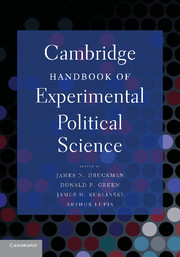Book contents
- Frontmatter
- Contents
- List of Tables
- List of Figures
- Contributors
- Acknowledgments
- INTRODUCTION
- PART I DESIGNING EXPERIMENTS
- PART II THE DEVELOPMENT OF EXPERIMENTS IN POLITICAL SCIENCE
- PART III DECISION MAKING
- PART IV VOTE CHOICE, CANDIDATE EVALUATIONS, AND TURNOUT
- PART V INTERPERSONAL RELATIONS
- PART VI IDENTITY, ETHNICITY, AND POLITICS
- PART VII INSTITUTIONS AND BEHAVIOR
- PART VIII ELITE BARGAINING
- PART IX ADVANCED EXPERIMENTAL METHODS
- 31 Treatment Effects
- 32 Making Effects Manifest in Randomized Experiments
- 33 Design and Analysis of Experiments in Multilevel Populations
- 34 Analyzing the Downstream Effects of Randomized Experiments
- 35 Mediation Analysis Is Harder Than It Looks
- AFTERWORD
- Name Index
- Subject Index
- References
35 - Mediation Analysis Is Harder Than It Looks
Published online by Cambridge University Press: 05 June 2012
- Frontmatter
- Contents
- List of Tables
- List of Figures
- Contributors
- Acknowledgments
- INTRODUCTION
- PART I DESIGNING EXPERIMENTS
- PART II THE DEVELOPMENT OF EXPERIMENTS IN POLITICAL SCIENCE
- PART III DECISION MAKING
- PART IV VOTE CHOICE, CANDIDATE EVALUATIONS, AND TURNOUT
- PART V INTERPERSONAL RELATIONS
- PART VI IDENTITY, ETHNICITY, AND POLITICS
- PART VII INSTITUTIONS AND BEHAVIOR
- PART VIII ELITE BARGAINING
- PART IX ADVANCED EXPERIMENTAL METHODS
- 31 Treatment Effects
- 32 Making Effects Manifest in Randomized Experiments
- 33 Design and Analysis of Experiments in Multilevel Populations
- 34 Analyzing the Downstream Effects of Randomized Experiments
- 35 Mediation Analysis Is Harder Than It Looks
- AFTERWORD
- Name Index
- Subject Index
- References
Summary
Mediators are variables that transmit causal effects from treatments to outcomes. Those who undertake mediation analysis seek to answer “how” questions about causation: how does this treatment affect that outcome? Typically, we desire answers of the form “the treatment affects a causally intermediate variable, which in turn affects the outcome.” Identifying these causally intermediate variables is the challenge of mediation analysis.
Conjectures about political mediation effects are as old as the study of politics. But codification of procedures by which to test hypotheses about mediation is a relatively new development. The most common procedures are now ubiquitous in psychology (Quiñones-Vidal et al. 2004) and increasingly popular in the other social sciences, not least political science.
Unfortunately, the most common procedures are not very good. They call for indirect effects – the portions of treatment effects that are transmitted through mediators – to be estimated via multiequation regression frameworks. These procedures do not require experimental manipulation of mediators; instead, they encourage the study of mediation with data from unmanipulated mediators (MacKinnon et al. 2002, 86; Spencer, Zanna, and Fong 2005). The procedures are therefore prone to producing biased estimates of mediation effects. Warnings about this problem have been issued for decades by statisticians, psychologists, and political scientists.
- Type
- Chapter
- Information
- Cambridge Handbook of Experimental Political Science , pp. 508 - 522Publisher: Cambridge University PressPrint publication year: 2011
References
- 54
- Cited by

